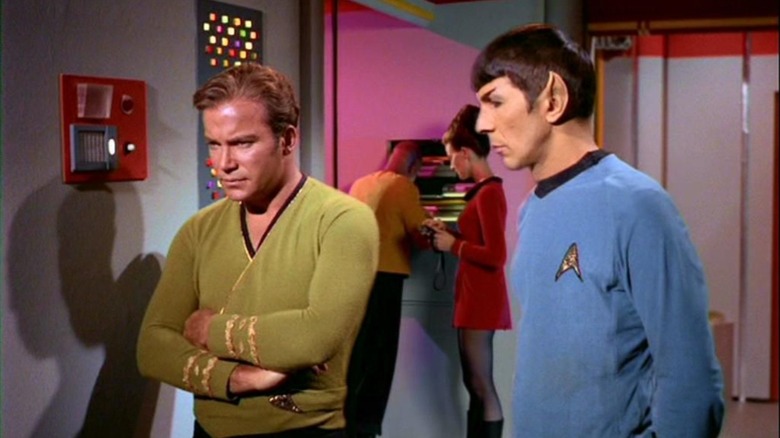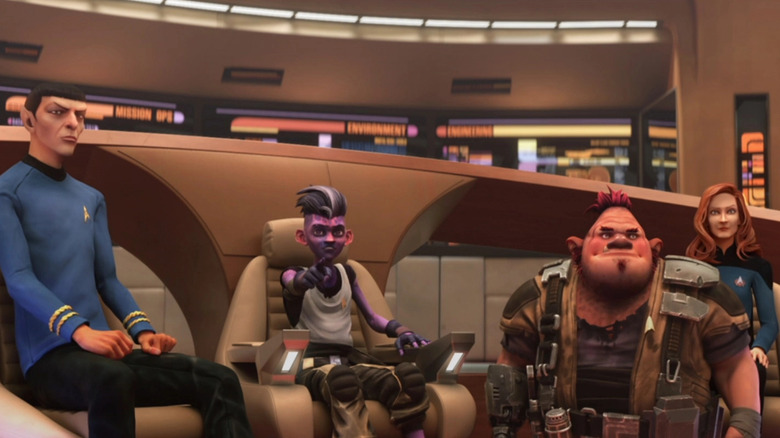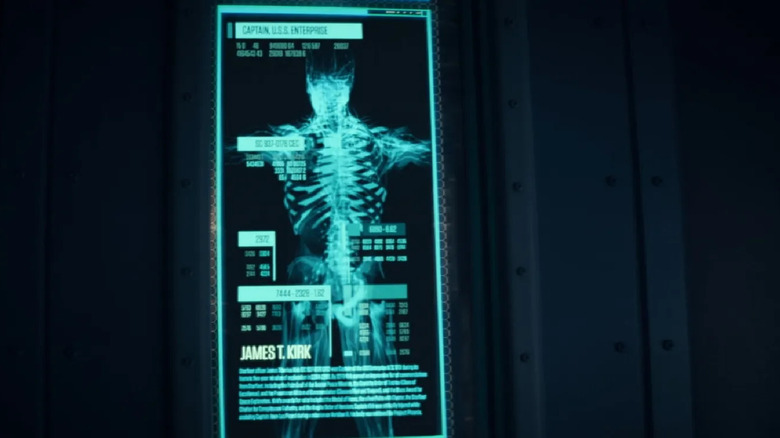Star Trek Has No Plans To Deepfake Beloved Characters Back To Life - Yet
In the "Star Trek: Deep Space Nine" episode "Trials and Tribble-ations" (November 4, 1996), Captain Sisko (Avery Brooks) and several other members of the "DS9" crew had to travel back in time to avert a crisis. It seems a time-traveling assassin had inserted himself into the events of the original series "Star Trek" episode "The Trouble with Tribbles" (December 29, 1967) and Sisko had to go undercover next to Captain Kirk (William Shatner) to prevent a bomb from blowing up. Using revolutionary special effects technology, Sisko, Dax (Terry Farrell), Dr. Bashir (Alexander Siddig), and others were inserted rather seamlessly into an episode that was shot 30 years prior. It was a novelty for "Star Trek," and one of the few times the franchise revisited its past in such a manner.
Many years later, "Star Trek: Prodigy" would do something similar in the episode "Kobayashi" (January 6, 2022). The teenage Dal (Brett Gray) wanted to take a holographic version of Trek's infamous Kobayashi Maru test and instructed the computer to create a ship and a crew that would increase his odds. Because "Prodigy" is animated, Dal was able to interact with Dr. Beverly Crusher (Gates McFadden) as well as Odo, Spock, Uhura, and Scotty (Rene Auberjonois, Leonard Nimoy, Nichelle Nichols, and James Doohan) all realized through posthumous stock audio. They operated from the bridge of the Enterprise-D.
To date, these episodes have been the closest "Trek" has come to incorporating actors who weren't on set.
Speaking to SFX magazine (via Games Radar), "Star Trek" executive producer Akiva Goldsman admitted that, while other major entertainment franchises have been using advanced effects to animate dead actors for newer projects, "Trek" will not be doing it anytime soon ... probably.
Star Trek: Legacy
It should be noted that, since Paramount+ launched in 2017, "Star Trek" has begun visiting a wide variety of points on its timeline. Some of the shows currently airing take place prior to the events of the original 1966 series, whereas others take place centuries later, well after the end of "Star Trek: Voyager." As such, the franchise has had every excuse to bring back whatever legacy characters they might want, in live-action or in animation.
"Star Trek: Strange New Worlds" has been the most notable in this regard, as it features a majority of legacy characters in central roles, including Spock (Ethan Peck), Uhura (Cela Rose Gooding), and even a visiting young James T. Kirk (Paul Wesley). Note that these characters are all played by new actors and are not being recreated via CGI. Compare that to "Rogue One: A Star Wars Story" — wherein advanced special effects were used to digitally "recreate" Carrie Fisher and Peter Cushing — and the subsequent episodes of "The Mandalorian" and "The Book of Boba Fett" featuring a massively de-age Mark Hamill and a replication of his voice.
When interviewed by SFX Magazine, Akiva Goldsman admitted there are elements and stories in "Star Trek" that he wishes he could address using deepfake tech, but that he wouldn't necessarily do it. For instance, he wishes he could re-do the death of Captain Kirk (the William Shatner version) in the 1994 film "Star Trek: Generations":
"My friend Terry Matalas [the 'Star Trek: Picard' showrunner] is not alone in feeling frustrated with Kirk's death in canon. It's why he put his body at Daystrom Station, right?"
In an episode of "Picard," it was revealed that Kirk's corpse was being stored in a Starfleet black site called Daystrom Station.
Kirk's body
Akiva Goldsman continued:
"It's a really hard thing to figure out how to do, but none of me opposes it. We just don't have plans for it. There are a few things that I would retcon if I could, and digital performers could help that. I think in theory, yes. Sadly, just practically speaking, we have no plans for it."
To remind the reader, Kirk — having been culled from a temporal nexus — died fighting Dr. Soren (Malcolm McDowell) on the rocky peaks of a distant planet. Captain Picard (Patrick Stewart) buried his body under a pile of rocks. It seems that Starfleet salvaged the body and stored it for decades, although there doesn't appear to have been a logical reason to have done so. With the body available at Daystrom Station, however, the "Star Trek" showrunners have given them an organic excuse to resurrect the character (perhaps via cloning, or through android golems), if they should want to. Shatner, however, is 91, and doesn't look the same he did in 1994. As such, CGI deep fakery may be required. Of course, once the cat is out of the bag, it's easy to imagine a dark future where the 1966 crew is back as their youthful selves, their voices recreated with A.I., computer-ly mouthing new adventures as CGI puppets.
"Star Trek," while currently obsessed with legacy, is also very good about expanding its parameters and boldly going to new places. Perhaps cooler heads will prevail and deepfakes will not be needed. Don't bring back an old character, please. Make us fall in love with a new one.


